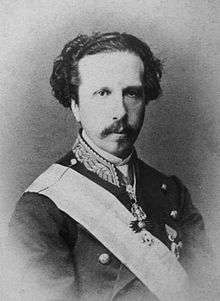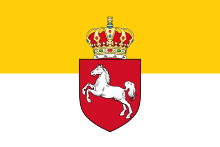Francis, Duke of Cádiz
Francisco de Asís María Fernando de Borbón, sometimes anglicised Francis of Assisi (13 May 1822 – 17 April 1902), was the husband of Queen Isabella II of Spain and king consort from 1846 to 1868. He is commonly styled Duke of Cádiz, the title he held before his marriage.
| Francisco de Asís | |||||
|---|---|---|---|---|---|
 Photograph by Herbert, c 1860 | |||||
| King consort of Spain | |||||
| Tenure | 10 October 1846 – 30 September 1868 | ||||
| Born | 13 May 1822 Royal Palace of Aranjuez, Aranjuez, Kingdom of Spain | ||||
| Died | 17 April 1902 (aged 79) Épinay-sur-Seine, Paris, French Third Republic | ||||
| Burial | |||||
| Spouse | |||||
| Issue |
| ||||
| |||||
| House | Bourbon | ||||
| Father | Infante Francisco de Paula of Spain | ||||
| Mother | Princess Luisa Carlotta of Naples and Sicily | ||||
| Religion | Roman Catholicism | ||||
Family
Francis was born at Aranjuez, Spain, the second son (first to survive infancy) of Infante Francisco de Paula of Spain, and of his wife (and niece), Princess Luisa Carlotta of Naples and Sicily. He was named after Saint Francis of Assisi.
Marriage and children
Francis married Isabella, his double first cousin, on 10 October 1846. There is evidence that Isabella would rather have married his younger brother, Infante Enrique, Duke of Seville, and complained bitterly about her husband's effeminate habits after their first night together.
Twelve children were born during the marriage, of whom five reached adulthood:
- Isabella, Princess of Asturias (1851–1931): married her mother's and father's first cousin Prince Gaetan, Count of Girgenti.
- Alfonso XII of Spain (1857–1885).
- Infanta María del Pilar (1861–1879).
- Infanta María de la Paz (1862–1946): married her paternal first cousin Prince Louis Ferdinand of Bavaria.
- Infanta Eulalia (1864–1958): married her maternal first cousin Don Antonio de Orléans y Borbón, Infante of Spain, Duke of Galliera.
There has been considerable speculation that some or all of Isabella's children were not fathered by Francis; this has been bolstered by rumours that Francis was either homosexual or impotent.
Later life
Starting in 1864, Francis acted as president of the Spanish Privy Council (Consejo del Reino).
In 1868 he went into exile with his wife in France and adopted the incognito title of Count of Moratalla. On 25 June 1870, Isabella abdicated in favour of their son, Alfonso XII—whom the 1874 restoration placed on the throne. By then, Francis and Isabella had amicably separated and, with time, became good friends.
In 1881 Francis took up residence at the château of Épinay-sur-Seine (currently the city hall). He died there in 1902. His wife Isabella and two of his daughters, Isabella and Eulalia, were present at his deathbed.[1]
Titles, styles and honours
.svg.png)
Titles and styles
- 13 May 1822 – 10 October 1846: His Royal Highness Infante Francis of Spain, The Duke of Cádiz
- 10 October 1846 – 25 June 1870: His Majesty The King of Spain
- 25 June 1870 – 17 April 1902: His Majesty King Francis
Honours
.svg.png)
- Order of the Golden Fleece, Knight, 14 May 1822[2][3]
- Royal and Distinguished Spanish Order of Charles III, Grand Cross, 14 May 1822[4]
- Order of Isabella the Catholic, Grand Cross, 27 January 1824[5][6]
.svg.png)
- Order of St. Januarius, Knight[7]
- Illustrious Royal Order of St. Ferdinand and Merit, Grand Cross[8]
.svg.png)
- Order of the Annunciation, Knight, 6 August 1849[9]
- Order of Saints Maurice and Lazarus, Grand Cross, 1849

.svg.png)
.svg.png)
.svg.png)

.svg.png)

.svg.png)
- House Order of Fidelity, Knight, 1866
- Order of the Zähringer Lion, Grand Cross, 1866





.svg.png)
Ancestry
| Ancestors of Francis, Duke of Cádiz | |||||||||||||||||||||||||||||||||||||||||||||||||||||||||||||||||||||||||||||||||||||||||||||||||||||||||||||||||||||||||||||||||||||||||||||||||||||||||||||||||||||||||||||||||||||||||||||||||||||||||||||||||||||||||||||||||||||||||||||||||||||||||||||||||||||||||||||||||||||||||
|---|---|---|---|---|---|---|---|---|---|---|---|---|---|---|---|---|---|---|---|---|---|---|---|---|---|---|---|---|---|---|---|---|---|---|---|---|---|---|---|---|---|---|---|---|---|---|---|---|---|---|---|---|---|---|---|---|---|---|---|---|---|---|---|---|---|---|---|---|---|---|---|---|---|---|---|---|---|---|---|---|---|---|---|---|---|---|---|---|---|---|---|---|---|---|---|---|---|---|---|---|---|---|---|---|---|---|---|---|---|---|---|---|---|---|---|---|---|---|---|---|---|---|---|---|---|---|---|---|---|---|---|---|---|---|---|---|---|---|---|---|---|---|---|---|---|---|---|---|---|---|---|---|---|---|---|---|---|---|---|---|---|---|---|---|---|---|---|---|---|---|---|---|---|---|---|---|---|---|---|---|---|---|---|---|---|---|---|---|---|---|---|---|---|---|---|---|---|---|---|---|---|---|---|---|---|---|---|---|---|---|---|---|---|---|---|---|---|---|---|---|---|---|---|---|---|---|---|---|---|---|---|---|---|---|---|---|---|---|---|---|---|---|---|---|---|---|---|---|---|---|---|---|---|---|---|---|---|---|---|---|---|---|---|---|---|---|---|---|---|---|---|---|---|---|---|---|---|---|---|---|---|
| |||||||||||||||||||||||||||||||||||||||||||||||||||||||||||||||||||||||||||||||||||||||||||||||||||||||||||||||||||||||||||||||||||||||||||||||||||||||||||||||||||||||||||||||||||||||||||||||||||||||||||||||||||||||||||||||||||||||||||||||||||||||||||||||||||||||||||||||||||||||||
References
- "Don Francisco d'Assisi", The Times (18 April 1902): 9.
- Kalendario manual y guía de forasteros en Madrid (in Spanish). Imprenta Real. 1834. Retrieved 2019-07-15.
- Nacional (Madrid), Imprenta (1866). Guía de forasteros en Madrid [para el año de 1866] (in Spanish). En la Imprenta Nacional. Retrieved 2019-07-15.
- Kalendario manual y guía de forasteros en Madrid (in Spanish). Imprenta Real. 1826. Retrieved 2019-07-15.
- Nacional (Madrid), Imprenta (1866). "Guía de forasteros en Madrid [para el año de 1866]" (in Spanish). En la Imprenta Nacional. Retrieved 2019-07-15.
- "Kalendario manual y guía de forasteros en Madrid" (in Spanish). Imprenta Real. 1826. Retrieved 2019-07-15.
- "Biblioteca ICAR - Almanacco Reale del Regno delle Due Sicilie per l'anno 1855". www.icar.beniculturali.it. Retrieved 2017-12-28.
- (Stato), Napoli (1841). Almanacco reale del Regno delle Due Sicilie: per l'anno .... 1841 (in Italian). Stamp. Reale. Retrieved 2017-12-28.
- Cibrario, Luigi (1869). Notizia storica del nobilissimo ordine supremo della santissima Annunziata. Sunto degli statuti, catalogo dei cavalieri (in Italian). Eredi Botta. p. 112. Retrieved 2019-03-04.
- Almanacco di corte (in Italian). 1858. Retrieved 2019-04-24.
- Hof- und Staats-Handbuch des Königreichs Bayern (in German). Königl. Oberpostamt. 1867. p. 10. Retrieved 2019-07-15.
- Hof- und Staats-Handbuch des Königreich Preußen (1886–87), "Orden und Ehrenzeichen" p. 39
- Staatshandbuch für den Freistaat Sachsen (1867) (in German), "Königliche Ritter-Orden", p. 4
- Journal de Monaco
- Sveriges statskalender (in Swedish), 1864, p. 422, retrieved 2018-01-06 – via runeberg.org
- Hof- und Staats-Handbuch des Großherzogtum Baden (1868), "Großherzogliche Orden" pp. 51, 61
- Hof- und Staats-Handbuch des Königreich Württemberg (1907), "Königliche Orden" p. 27
- Hof- und Staats-Handbuch des Großherzogtum Hessen (1879), "Großherzogliche Orden und Ehrenzeichen" p. 11
- Hof- und Staats-Handbuch des Königreich Hannover (1865), "Königliche Orden und Ehrenzeichen" p. 38
- "A Szent István Rend tagjai" Archived 22 December 2010 at the Wayback Machine
- Jørgen Pedersen (2009). Riddere af Elefantordenen, 1559–2009 (in Danish). Syddansk Universitetsforlag. p. 470. ISBN 978-87-7674-434-2.
- M. & B. Wattel. (2009). Les Grand'Croix de la Légion d'honneur de 1805 à nos jours. Titulaires français et étrangers. Paris: Archives & Culture. p. 448. ISBN 978-2-35077-135-9.
- Genealogie ascendante jusqu'au quatrieme degre inclusivement de tous les Rois et Princes de maisons souveraines de l'Europe actuellement vivans [Genealogy up to the fourth degree inclusive of all the Kings and Princes of sovereign houses of Europe currently living] (in French). Bourdeaux: Frederic Guillaume Birnstiel. 1768. p. 9.
- Calvo Maturana, Antonio Juan. "Francisco de Paula Antonio María de Borbón". Diccionario biográfico España (in Spanish). Real Academia de la Historia.
- Genealogie ascendate, p. 96
- Chisholm, Hugh, ed. (1911). . Encyclopædia Britannica. 10 (11th ed.). Cambridge University Press.
- Mateos Sáinz de Medrano, Ricardo. "Luisa Carlota de Borbón y Borbón". Diccionario biográfico España (in Spanish). Real Academia de la Historia.
- Navarrete Martínez, Esperanza Navarrete Martínez. "María de la O Isabel de Borbón". Diccionario biográfico España (in Spanish). Real Academia de la Historia.
Bibliography
Bergamini, John D. The Spanish Bourbons: The History of a Tenacious Dynasty. New York: Putnam, 1974. ISBN 0-399-11365-7
Francis, Duke of Cádiz Cadet branch of the Capetian dynasty Born: 13 May 1822 Died: 17 April 1902 | ||
| Spanish royalty | ||
|---|---|---|
| Vacant Title last held by Maria Christina of the Two Siciliesas queen consort |
King consort of Spain 10 October 1846 – 30 September 1868 |
Vacant Title next held by Maria Vittoria dal Pozzoas queen consort |
| Titles in pretence | ||
| Loss of title |
— TITULAR — King consort of Spain 30 September 1868 – 25 June 1870 |
Vacant Title next held by Victoria Eugenie of Battenbergas queen consort |